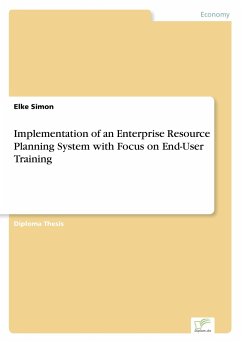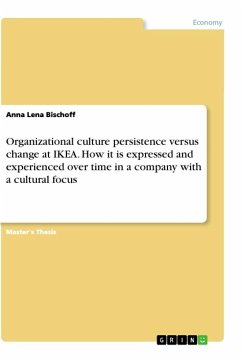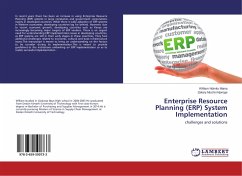Diploma Thesis from the year 1999 in the subject Business economics - Supply, Production, Logistics, grade: 1,0, University of Applied Sciences Fulda (Informatik), language: English, abstract: Inhaltsangabe:Abstract:
The implementation of an Enterprise Resource Planning (ERP) system refers to Information Systems, Business Processes, and People. Basically, it is a changing procedure in organizations that strive for company-wide high performance. Business Process Transformation is about changing a company s focus - from products to customers. Information Systems are replaced by a homogenous system environment which integrates all information into a common system. The behaviour and skills of the company-wide personnel are adapted to perform in the new "world".
The big challenge of the implementation is to have the properly-trained people for a high-performance organization. Unfortunately, most companies do not recognize that need. They underestimate the impact that the human factor has on an ERP approach; they consider the implementation as a software-installation with influence to the business. But, the implementation is much more complex.
This thesis is dedicated to all those persons who intend to implement an Enterprise Resource Planning system, and who want to understand the theory of Business Process Transformation and how it is linked to Enterprise Resource Planning. To emphasize the importance of the human factors within the implementation, chapter 4 elaborates on End-User Training as a significant part of an implementation for a company dedicated to becoming a high-performance organization.
This paper also includes a case study of an ERP implementation at Mitel Corporation. The case study presents information about the Company, its ERP implementation, and its approach to End-User Training.
Inhaltsverzeichnis:Table of Contents:
AcknowledgementIII
ContentsIV
List of IllustrationsVII
List of TablesVIII
List of TermsIX
Abstract1
1.Introduction2
2.Business Process Transformation (BPT)4
2.1Origins of Today s Organisations4
2.1.1History4
2.1.2Typical Business Process5
2.2Business Process Transformation Terminology7
2.2.1Motives for Business Process Transformation7
2.2.2Reengineering - The Radical Change9
2.2.3Improvement - The Incremental Change11
2.2.4Reengineering versus Improvement12
2.3From the Functional to the Process-oriented Organization15
2.3.1Functional Organization15
2.3.2Process-oriented Organization17
3.Enterprise Resource Planning (ERP)19
3.1Business Process Transformation as a Pre-requisite20
3.2SAP R/3 System - A Tool for BPT21
3.2.1Introduction of SAP21
3.2.2SAP R/3 System Technology22
3.2.3SAP R/3 System Features25
3.3SAP Implementation27
3.3.1Strategies27
3.3.2Methodologies30
4.End-User Training (EUT)35
4.1Roles in an Organization35
4.1.1Role of End-Users36
4.1.2Role of Leaders37
4.1.3Resistance38
4.2Objectives of a High-Performance Organization38
4.2.1Empowerment38
4.2.2Generalist38
4.2.3Team-Work38
4.3Change Management Approaches38
4.3.1Communication38
4.3.2Stakeholder Analysis38
4.3.3End-User Training38
5.Mitel Corporation - A Case Study38
5.1Mitel Corporation: Background38
5.1.1History38
5.1.2Mitel Corporation Today38
5.2Implementing SAP R/3 System38
5.2.1Project GENESIS38
5.2.2Change Management38
5.3End-User Training38
5.3.1End-User-Training Requirements38
5.3.2Current Situation38
5.3.3End-User-Training Strategy38
6.Summary38
AppendixXXXVIII
Appendix A Project Genesis: Organization ChartXXXVIII
Appendix B Project Genesis: Roles and ResponsibilitiesXXXVIII
BibliographyXXXVIII
DisclaimerXXXVIII
The implementation of an Enterprise Resource Planning (ERP) system refers to Information Systems, Business Processes, and People. Basically, it is a changing procedure in organizations that strive for company-wide high performance. Business Process Transformation is about changing a company s focus - from products to customers. Information Systems are replaced by a homogenous system environment which integrates all information into a common system. The behaviour and skills of the company-wide personnel are adapted to perform in the new "world".
The big challenge of the implementation is to have the properly-trained people for a high-performance organization. Unfortunately, most companies do not recognize that need. They underestimate the impact that the human factor has on an ERP approach; they consider the implementation as a software-installation with influence to the business. But, the implementation is much more complex.
This thesis is dedicated to all those persons who intend to implement an Enterprise Resource Planning system, and who want to understand the theory of Business Process Transformation and how it is linked to Enterprise Resource Planning. To emphasize the importance of the human factors within the implementation, chapter 4 elaborates on End-User Training as a significant part of an implementation for a company dedicated to becoming a high-performance organization.
This paper also includes a case study of an ERP implementation at Mitel Corporation. The case study presents information about the Company, its ERP implementation, and its approach to End-User Training.
Inhaltsverzeichnis:Table of Contents:
AcknowledgementIII
ContentsIV
List of IllustrationsVII
List of TablesVIII
List of TermsIX
Abstract1
1.Introduction2
2.Business Process Transformation (BPT)4
2.1Origins of Today s Organisations4
2.1.1History4
2.1.2Typical Business Process5
2.2Business Process Transformation Terminology7
2.2.1Motives for Business Process Transformation7
2.2.2Reengineering - The Radical Change9
2.2.3Improvement - The Incremental Change11
2.2.4Reengineering versus Improvement12
2.3From the Functional to the Process-oriented Organization15
2.3.1Functional Organization15
2.3.2Process-oriented Organization17
3.Enterprise Resource Planning (ERP)19
3.1Business Process Transformation as a Pre-requisite20
3.2SAP R/3 System - A Tool for BPT21
3.2.1Introduction of SAP21
3.2.2SAP R/3 System Technology22
3.2.3SAP R/3 System Features25
3.3SAP Implementation27
3.3.1Strategies27
3.3.2Methodologies30
4.End-User Training (EUT)35
4.1Roles in an Organization35
4.1.1Role of End-Users36
4.1.2Role of Leaders37
4.1.3Resistance38
4.2Objectives of a High-Performance Organization38
4.2.1Empowerment38
4.2.2Generalist38
4.2.3Team-Work38
4.3Change Management Approaches38
4.3.1Communication38
4.3.2Stakeholder Analysis38
4.3.3End-User Training38
5.Mitel Corporation - A Case Study38
5.1Mitel Corporation: Background38
5.1.1History38
5.1.2Mitel Corporation Today38
5.2Implementing SAP R/3 System38
5.2.1Project GENESIS38
5.2.2Change Management38
5.3End-User Training38
5.3.1End-User-Training Requirements38
5.3.2Current Situation38
5.3.3End-User-Training Strategy38
6.Summary38
AppendixXXXVIII
Appendix A Project Genesis: Organization ChartXXXVIII
Appendix B Project Genesis: Roles and ResponsibilitiesXXXVIII
BibliographyXXXVIII
DisclaimerXXXVIII








